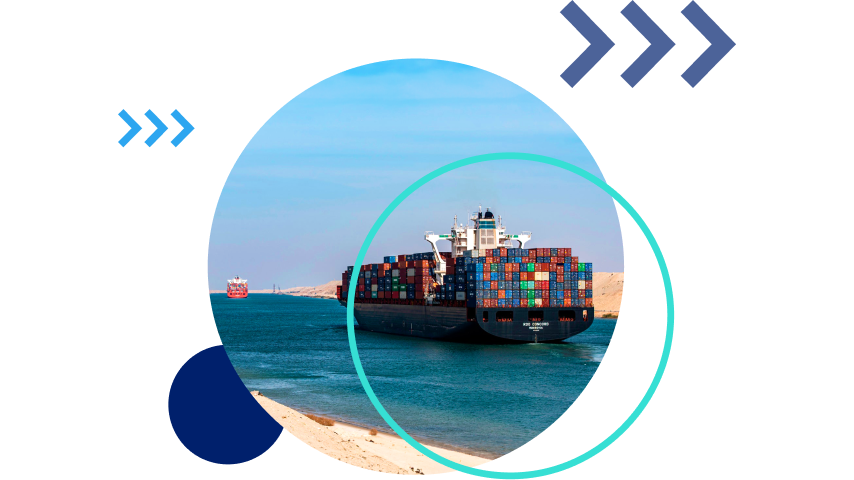The situation in the Red Sea is changing fast. Click here for the latest update.
Widespread diversions of container carriers away from the Red Sea to avoid Houthi attacks is likely to impact shippers on affected lanes in the form of longer lead times and higher freight rates as carriers take longer routes with higher costs. But with alternative routes and plenty of excess capacity available, operations should continue reasonably well, and freight rates are unlikely to spike to extreme highs. With the international community mobilizing and motivated to remove this disruption to global trade, it is also possible that these diversions could be relatively short lived.
Suez Canal News Update
The Suez Canal is a crucial lane for global shipping, with 50-60 vessels of all types transiting each day for about 19,000 per year, including about 30% of global container traffic and more than a million barrels of crude oil per day.
Since mid-November multiple ships have been attacked in the Red Sea by Houthi forces in Yemen. With the threat and frequency of attacks increasing and many container carriers now diverting away from the Suez Canal as a result, the international maritime community is mobilizing to restore security, though in the meantime disruptions are increasing too.
Marine Attacks in the Red Sea Shipping Lane
In mid-November 2023, Houthis in Yemen threatened to attack Israel affiliated vessels sailing in the Red Sea as a show of support for Hamas during the Israel – Hamas war. This began on November 18th when an Israeli-owned car carrier was hijacked by Houthis – it remains held in Yemen.
Late November and early December saw multiple drone and missile attacks and attempted hijackings in the Bab el-Mandab Strait on container vessels and bulk carriers with ties to Israeli ownerships, as well as attacks of US navy vessels.
By mid-December the Houthis expanded their threat to include all Israel-bound – not just Israeli-owned – vessels, and attacked a tanker it claimed was bound for Israel on Tuesday. A French Navy vessel assisted the tanker and shot down a drone headed the tanker’s way.
Last week Houthis fired a rocket that fell just short of a Maersk vessel near Yemen, and on Friday a Hapag-Lloyd container ship was hit by a projectile in the Bab al-Mandab Strait, reporting the loss of a container and the outbreak of a fire, and an MSC ship took evasive maneuvers to avoid Yemeni waters. An additional bulk vessel was reportedly boarded by Somali pirates.
This escalation led to the widespread decision by carriers to avoid the Red Sea altogether, forgoing the usage of the Suez Canal.
This has profound implications.
The Suez Canal is the shortest route for container traffic from Asia to the Mediterranean and Europe, and is also used for some volumes from the Far East or Southern Asia to North America. Diverting around the southern tip of Africa adds 2,500 – 3,500 nautical miles and 7 to 10 days for ships sailing to Northern Europe or North America, and as much as 7,000 nm for some Mediterranean destinations. In addition to time, the fuel implications add up significantly both from a cost perspective and in terms of carbon emissions.
Ocean Container Traffic Diversions in Suez Canal
Though there had been a handful of announced diversions since November only ZIM Lines had rerouted its Asia – Mediterranean service prior to this week. But on Saturday Maersk announced that all its vessels set to transit through the Bab al-Mandab Strait would pause their journey until further notice, and was followed by Hapag-Lloyd, CMA CGM and MSC announcing they would divert vessels away from the Red Sea and Suez Canal until safety was restored.
Together with ZIM, these carriers represent five of the top ten largest carriers and 56% of global capacity. OOCL is the only carrier to announce they will suspend service to and from Israel in response. Oil tankers have also begun avoiding the Red Sea.
Diversions announced by these five carriers so far mean that 17% of global volumes will be taking the longer, more expensive and more carbon intensive routes.
International Response to the Red Sea Threat
Navy vessels from multiple countries including the US, Japan and France are already in the region as part of the Combined Maritime Task Force 153 established in 2022 to ensure Red Sea security, and have assisted vessels that came under attack or intercepted drone attacks since the Houthi threat emerged, with some US vessels have been targeted directly.
But with the escalation of hostilities – and now the broad impact on maritime flows – the US has announced the launch of Operation Prosperity Guardian which will work alongside CMF 153 to address the Houthi threat and will include support from the US, the United Kingdom, Bahrain, Canada, France, Italy, Netherlands, Norway, Seychelles and Spain.
Houthi Impact on Container Rates So Far
In terms of impacts on container shipping prices – in addition to ZIM Lines, Hapag-Lloyd and Maersk who are all charging a war risk surcharge of between $20 and $100 per container to and from Israel – ZIM, which was already diverting its vessels that normally use the Red Sea, increased rates for its Asia – Mediterranean service, up to the $3,300-$3,400/FEU range – well above the latest Freightos Baltic Index Asia – Mediterranean benchmark of $2,552/FEU. With the other major carriers also rerouting now, it is likely freight rates will rise for Asia – N. Europe and Mediterranean volumes with these carriers as well.
What to expect from shipping in the Suez Canal & Red Sea?
Shipping through the Suez Canal will take more time.
As widespread diversions are in place for now, and due to the longer distance required to avoid the Red Sea, importer/exporters on these trade lanes can expect delays and should plan for longer lead times of one to two weeks until the disruption is resolved.
As frequently happens in supply chains, this could have a potential knock-on effect. Supply chains are increasingly interconnected and delays of parts have a tendency to accrue. If vessels arrive off schedule or more than one at a time, some port congestion could be the result. One saving grace may be the timing, as December and early January are typically slow, post-holiday season times for ocean freight.
In terms of freight rates, it is tempting to look back to 2021 when a container vessel blocked the Suez Canal for several days. The blockage caused delays and congestion in its aftermath, but as port congestion was already bad and rates were already 4.5X their norm due to pandemic-driven increases in ocean freight, the blockage really made a bad situation worse but was not the overall driver of high rates and delays at the time.
Get Your Free Custom Data Report
Learn how customized freight data visibility could align with your unique business needs.
But this time there is excess capacity to step in.
The other big difference this time is the excess capacity available to address the disruption: in 2021 there were no extra available ships to take the place of delayed vessels at origin ports. This time there is a record level of excess capacity due to the delivery of a record number of new, larger, container ships this year, especially on Asia – Europe lanes.
Asia – N. Europe and Mediterranean container rates have been increasing in December – even before these widespread diversions – only as a result of carriers reducing capacity by canceling sailings. But carriers will now need to operate a larger number of vessels to maintain their scheduled sailings for their diverted services.
So, we can expect the need for longer voyages until the Houthi threat is removed to push container prices up on affected lanes, but the widespread availability of extra capacity at the moment may mitigate the extent of this price increase, and avoid the extreme spikes in rates seen during the pandemic. Increasing rates may, however, prove to be a detrimental anchor for global supply chain organizations that are now embarking on their annual ocean freight contract negotiations.
There’s also a track record of solving threats to vessel safety
Finally, taking as a precedent the Somali pirate attacks which likewise posed a serious threat to Red Sea trade from about 2010 to 2018, coordinated international naval operations which included all five UN Security Council permanent members was one key element that did successfully manage to restore security to this crucial lane.
As the threat of Houthi attacks is now significantly impacting vessel traffic on this crucial waterway and the international response is already underway, it is also possible that these widespread diversions will be short lived.
The Bottom Line: Red Sea & Suez Canal Shipping News
Shippers on affected lanes should expect longer lead times and higher freight rates until the Houthi threat is brought under control. But operations should continue reasonably well until then, and freight rates are unlikely to spike to extreme highs due to the current high levels of available capacity. With the international community mobilizing and motivated to remove this disruption to global trade, it is also possible that these diversions will not last very long.



